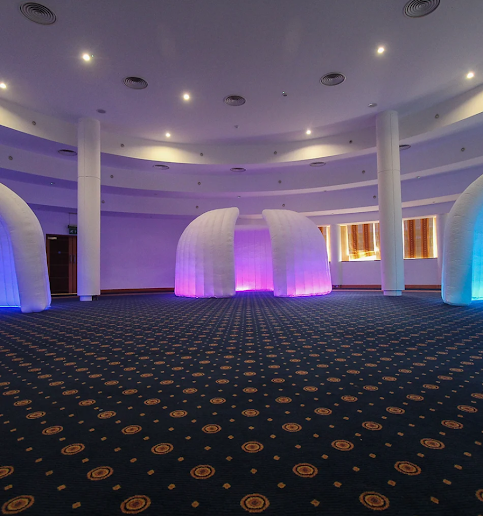Flexible Spaces, Dynamic Meetings: Unveiling the Pop-Up Conference Room Concept
In the fast-evolving landscape of modern work environments, the traditional notion of static meeting spaces is undergoing a transformative shift. The rise of remote work, flexible schedules, and the need for agile collaboration has given birth to innovative solutions such as pop-up conference rooms. This article explores the concept of pop up conference room, shedding light on their design philosophy, technology integration, benefits, and their impact on the overall work experience.
Introduction to Pop-Up Conference Rooms
The conventional office setup, with fixed conference rooms, is increasingly proving to be insufficient in catering to the dynamic nature of contemporary work. Pop-up conference rooms represent a paradigm shift, offering flexibility and adaptability. These mobile or modular spaces can be quickly set up and dismantled, providing a versatile solution for impromptu meetings, team collaborations, or client presentations.
Adaptable Environments for Modern Work
The essence of pop-up conference rooms lies in their ability to adapt to the changing needs of a modern workforce. Unlike traditional meeting rooms, which are often booked in advance and may go unused for extended periods, pop-up rooms can be deployed as needed. This adaptability aligns seamlessly with the flexible schedules and remote work arrangements that have become increasingly prevalent.
The Design Philosophy Behind Dynamic Meetings
The design of pop-up conference rooms revolves around maximizing efficiency without compromising on functionality and aesthetics. These spaces often incorporate modular furniture, movable partitions, and advanced audiovisual equipment. The goal is to create an environment that fosters collaboration while maintaining a professional atmosphere, regardless of the location or setting.
Technology Integration: Enhancing Conference Room Flexibility
Technology plays a crucial role in the effectiveness of pop-up conference rooms. Integration of state-of-the-art audiovisual systems, wireless connectivity, and smart room controls ensures that these spaces are fully equipped for productive meetings. This integration allows teams to seamlessly connect, share information, and collaborate, irrespective of the location or size of the pop-up room.
Benefits of Pop-Up Conference Rooms in Workspace Optimization
Cost-Efficiency: Pop-up conference rooms eliminate the need for dedicated, static meeting spaces, reducing real estate costs. Companies can invest in versatile furniture and technology that can be utilized across various areas of the office.
Increased Productivity: The ability to set up impromptu meetings encourages spontaneous collaboration, fostering creativity and innovation. Pop-up conference rooms enable teams to meet quickly, address issues, and make decisions in a timely manner.
Agile Work Culture: These flexible spaces promote an agile work culture, where employees have the freedom to choose where and how they work. This can enhance employee satisfaction and contribute to a positive work environment.
Case Studies: Successful Implementations and Transformations
Examining real-world examples of organizations that have adopted pop-up conference rooms provides valuable insights into the practical implications and benefits. Case studies can showcase how companies have leveraged these dynamic spaces to enhance collaboration, streamline communication, and create a more adaptable work environment.
User Experience: Navigating Dynamic Meetings in Pop-Up Spaces
User experience is paramount in the success of any workspace innovation. The article delves into the perspective of employees who have utilized pop-up conference rooms, exploring their feedback, challenges faced, and how these dynamic spaces have positively impacted their work routines.
Addressing Challenges and Finding Solutions
While pop-up conference rooms offer numerous advantages, they are not without challenges. This section examines potential issues such as technology glitches, privacy concerns, and the need for proper management and logistics. Solutions and best practices are discussed to ensure the seamless integration of pop-up conference rooms into the daily operations of a workplace.
Future Trends: Evolving the Pop-Up Conference Room Concept
As the workplace continues to evolve, so too will the concept of pop-up conference rooms. This section explores emerging trends such as augmented reality (AR) integration, enhanced connectivity features, and sustainable design practices. Predictions and expert insights offer a glimpse into the future of these dynamic meeting spaces.
Implementing a Pop-Up Conference Room Strategy in Your Workspace
For organizations considering the adoption of pop-up conference rooms, practical guidance is provided on implementing a successful strategy. This includes considerations for space planning, technology investment, employee training, and change management. Tips for creating a seamless transition to a more flexible and dynamic work environment are shared.
Conclusion
In conclusion, the introduction of pop-up conference rooms signifies a progressive departure from conventional meeting spaces, offering unparalleled flexibility and adaptability. As the modern workforce continues to embrace dynamic work structures, these innovative spaces prove instrumental in fostering collaboration, enhancing productivity, and optimizing workspace efficiency. Looking forward, the integration of large inflatable cubes into this evolving concept presents an exciting prospect for even more versatile and creative meeting environments. These inflatable cubes, with their unique design and portability, promise to redefine the boundaries of traditional workspaces, aligning seamlessly with the ever-changing demands of the contemporary business landscape.




Comments
Post a Comment